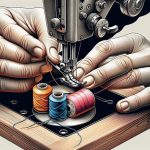Threading a needle on a Brother sewing machine is like finding the key to unlock a world of creative possibilities. To master this essential skill, you need a few simple but effective tips.
Understanding the needle and thread is the first step. Make sure you are using the correct type and size of needle for your project. The thread should also be compatible with the needle and the fabric you are working with.
Utilizing the built-in needle threader can make the process much easier. Follow the instructions in your sewing machine's manual to learn how to use it properly.
Proper bobbin placement and tension are also crucial for successful threading. Make sure the bobbin is inserted correctly and that the thread is properly wound around it. Adjust the tension according to your machine's specifications.
Using adequate lighting and magnification can greatly assist you in threading the needle. This will help you see the small details clearly and avoid any mistakes.
Regular maintenance and cleaning are important for keeping your sewing machine in good working condition. Dust and debris can accumulate over time and affect the threading process. Follow the manufacturer's recommendations for maintenance and cleaning to ensure smooth threading.
By following these tips, you can effortlessly thread your needle and dive into your sewing projects with confidence and ease. Let's get started on mastering this fundamental aspect of your sewing machine.
Key Takeaways
- Use the correct type and size of needle for your project
- Utilize the built-in needle threader for easy threading
- Properly place and adjust the bobbin tension for smooth stitching
- Ensure adequate lighting and magnification for accurate threading
Understanding the Needle and Thread
When threading a needle on your Brother sewing machine, understanding the needle and thread is essential for smooth and accurate stitching. The needle size is a crucial factor to consider. Different fabrics and threads require different needle sizes for optimal results. A general rule of thumb is to use a smaller needle for lighter weight fabrics and a larger needle for heavier fabrics. For instance, when working with lightweight fabrics like silk or chiffon, a size 9 or 11 needle is suitable, while for denim or upholstery fabric, a size 16 or 18 needle is more appropriate.
Equally important is the thread thickness. The thread you choose should complement the fabric and needle size. Thicker threads work well with larger needle sizes and heavier fabrics, while finer threads are suitable for smaller needle sizes and lightweight fabrics. Matching the thread thickness to the needle and fabric ensures that the stitches are secure and the fabric isn't damaged during sewing.
Utilizing the Built-in Needle Threader
To utilize the built-in needle threader on your Brother sewing machine, align the needle and thread according to the machine's instructions. First, raise the needle to its highest position using the hand wheel. Then, pull the thread across the designated guides and through the threader mechanism, following the arrows indicated.
Once the thread is in place, lower the presser foot and pull about 4-6 inches of thread through the needle. Now, engage the needle threader by lowering the needle threader lever. This action will cause a small hook to pass through the eye of the needle and catch the thread. Gently release the lever and the thread should be pulled through the needle.
If you're experiencing difficulty with the needle threader, ensure that the needle is properly inserted and not bent. Additionally, check that the thread is passing smoothly through the threader mechanism.
Proper Bobbin Placement and Tension
You frequently need to ensure that the bobbin is placed correctly and the tension is adjusted properly for smooth and precise stitching on your Brother sewing machine. Proper bobbin placement and tension are crucial for achieving high-quality sewing results.
To ensure proper bobbin placement and tension on your Brother sewing machine, follow these essential steps:
- Bobbin Winding: Wind the bobbin evenly and ensure it's placed in the bobbin case with the thread unwinding in the correct direction.
- Thread Tension: Adjust the bobbin tension using the appropriate screw on the bobbin case to achieve the correct tension for your specific fabric and thread.
- Proper Needle Insertion: Make sure to insert the needle properly, ensuring it's fully secured and in the correct position for smooth stitching.
- Needle Size: Choose the right needle size for the type of fabric you're sewing to prevent issues such as skipped stitches or fabric damage.
- Regular Maintenance: Keep your sewing machine clean and well-oiled to maintain proper bobbin placement and tension.
Using Adequate Lighting and Magnification
Once you have ensured proper bobbin placement and tension, it's essential to use adequate lighting and magnification to assist you in threading the needle on your Brother sewing machine. Proper posture is crucial when threading the needle, so sit or stand in a way that allows you to see the needle and its eye clearly.
Adequate lighting is important to illuminate the needle area. Position your machine near a natural light source or use a bright task light to ensure good visibility. Additionally, consider using a magnifying glass or a magnifying attachment for your sewing machine to help you see the tiny details more clearly.
When using magnification, it's important to also consider the needle size. Make sure the needle is appropriate for the thread and fabric you're using. A larger needle may require more magnification to see the eye clearly, while a smaller needle may be easier to thread without magnification.
Regular Maintenance and Cleaning
After you have completed threading the needle on your Brother sewing machine, it's important to regularly maintain and clean the machine to ensure optimal performance.
Regular maintenance and cleaning are essential for keeping your Brother sewing machine in top condition. Here are some important tips to help you maintain and clean your machine effectively:
- Use a small brush or vacuum attachment to remove lint and dust from the machine, especially in and around the bobbin case and feed dogs.
- Apply a small amount of sewing machine oil to the designated points as indicated in your machine's manual to lubricate moving parts and prevent rust.
- Wipe down the exterior of the machine with a soft, dry cloth to remove any dust or residue.
- Consider using compressed air to remove hard-to-reach debris from the machine.
- Schedule regular professional servicing to ensure that your machine receives thorough maintenance and cleaning.
Frequently Asked Questions
Can I Use Any Type of Thread With a Brother Sewing Machine, or Are There Specific Types That Work Best?
You can use various thread types with a Brother sewing machine, but it's best to choose threads compatible with your machine and project. When threading, ensure proper techniques, and maintain a sharp needle for optimal results.
How Do I Prevent the Thread From Getting Tangled or Stuck in the Machine While Threading the Needle?
To prevent tangles and ensure smooth threading on your Brother sewing machine, use the proper needle size for your fabric. This helps the thread glide through smoothly, reducing the risk of snags and jams.
Are There Any Specific Techniques for Threading a Needle on a Brother Sewing Machine That Differ From Other Machines?
When threading a needle on a Brother sewing machine, use specific threading techniques to prevent tangles. Pay attention to needle size and eyelet size to troubleshoot any issues. It's crucial for smooth and efficient sewing.
What Should I Do if the Needle Threader on My Machine Is Not Working Properly?
If the needle threader on your machine is not working properly, try troubleshooting it by checking for any obstructions or bent parts. You can also try using needle threading hacks like using a magnifier or a needle threader tool.
Are There Any Special Tips for Threading Needles With Very Small Eyelets on a Brother Sewing Machine?
When dealing with small eyelets on a Brother sewing machine, try manual needle threading techniques if the needle threader malfunctions. Troubleshoot by adjusting the lighting and using a magnifying glass for better visibility.
- Heat Transfer Printing: Best Practices for Vibrant Designs - July 23, 2024
- Exploring the World of Smart Fabrics and Wearable Tech - July 23, 2024
- 3D Printing: Transforming the Textile Industry - July 23, 2024







